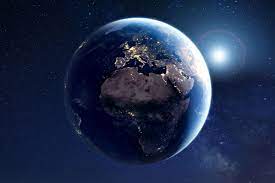The Wonders of Earth
Earth, our home planet, is a remarkable place that teems with life, beauty, and awe-inspiring natural wonders. From the vast oceans to the towering mountains, from lush forests to arid deserts, Earth offers an incredible diversity of landscapes and ecosystems.
One of the most fascinating aspects of our planet is its ability to sustain life. With its perfect distance from the sun and a unique combination of atmospheric conditions, Earth provides us with a nurturing environment that allows for the existence of a wide array of species.
The earth’s biosphere is a complex web of interconnected life forms. From tiny microorganisms to majestic mammals, every living being plays a crucial role in maintaining the delicate balance of nature. The intricate relationships between plants, animals, and their habitats create intricate ecosystems that support life in all its forms.
Earth’s oceans cover about 70% of its surface and are home to countless species. They not only provide habitat for marine life but also regulate our climate by absorbing carbon dioxide and releasing oxygen through photosynthesis performed by phytoplankton. The oceans are an endless source of inspiration and discovery.
On land, we find breathtaking landscapes that captivate our senses. Towering mountains challenge us to reach new heights while reminding us of the immense power and beauty that nature possesses. Lush forests offer sanctuary to numerous plants and animals while producing oxygen and purifying the air we breathe.
Even in seemingly harsh environments like deserts, life manages to thrive in extraordinary ways. Desert plants have adapted remarkable strategies to conserve water and withstand extreme temperatures. These arid landscapes hold hidden treasures waiting to be explored.
Beyond its natural wonders, Earth is also home to diverse cultures, languages, and civilizations. The human experience is intricately intertwined with the planet we inhabit. Our connection to the earth goes beyond the physical; it is a spiritual and emotional bond that shapes our identity and sense of belonging.
As inhabitants of this incredible planet, we have a responsibility to protect and preserve its beauty and resources for future generations. By embracing sustainable practices, conserving energy, reducing waste, and promoting biodiversity, we can ensure that Earth continues to thrive.
Let us marvel at the wonders of Earth and be grateful for the abundance it provides. May we cherish its natural splendor, respect its delicate ecosystems, and work together to create a harmonious coexistence between humans and nature. Earth is our precious home – let us care for it with love and gratitude.
4.
- What are 5 facts about Earth?
- How did Earth get its name NASA?
- What is the real name of Earth?
- How big is Pluto?
What are 5 facts about Earth?
There are countless fascinating facts about our planet Earth, but here are five intriguing ones to pique your curiosity. First, Earth is the third planet from the sun and the only known celestial body to support life. Second, it has a diameter of approximately 12,742 kilometers (7,918 miles) and a circumference of about 40,075 kilometers (24,901 miles). Third, Earth’s atmosphere is composed primarily of nitrogen (78%) and oxygen (21%), with trace amounts of other gases. Fourth, our planet has a diverse range of ecosystems, from dense rainforests to vast deserts and icy polar regions. Finally, Earth’s rotation causes day and night cycles while its tilt gives rise to the changing seasons we experience throughout the year. These facts offer just a glimpse into the wonders that make Earth such an extraordinary place.
How did Earth get its name NASA?
The name “Earth” has its origins in ancient English and Germanic languages. It is derived from the Old English word “eorþe,” which can be traced back to the Proto-Germanic word “erthō.” The term refers to the ground or soil, emphasizing the solid foundation of our planet. The name “Earth” has been used for centuries across various cultures and civilizations to describe our home planet. When it comes to NASA, as the United States’ space agency, they adopted the name “Earth” to refer to our planet in their scientific research, exploration, and communication with astronauts and space missions.
What is the real name of Earth?
The real name of Earth is simply “Earth”. It is the common and widely accepted name for our planet in English and many other languages. While different cultures may have their own names for Earth in their respective languages, the universally recognized name used by scientists, scholars, and the general population is “Earth”. It represents our home, the third planet from the sun, and holds immense significance as it supports and sustains life as we know it.
How big is Pluto?
Pluto, once considered the ninth planet of our solar system, is now classified as a dwarf planet. Despite its smaller size, Pluto still holds great intrigue and fascination. With a diameter of approximately 1,473 miles (2,370 kilometers), Pluto is significantly smaller than Earth. To put it into perspective, Pluto is about 18% the size of our planet. Although it may be small in comparison, Pluto continues to captivate scientists and space enthusiasts alike with its unique characteristics and mysteries waiting to be unraveled.

